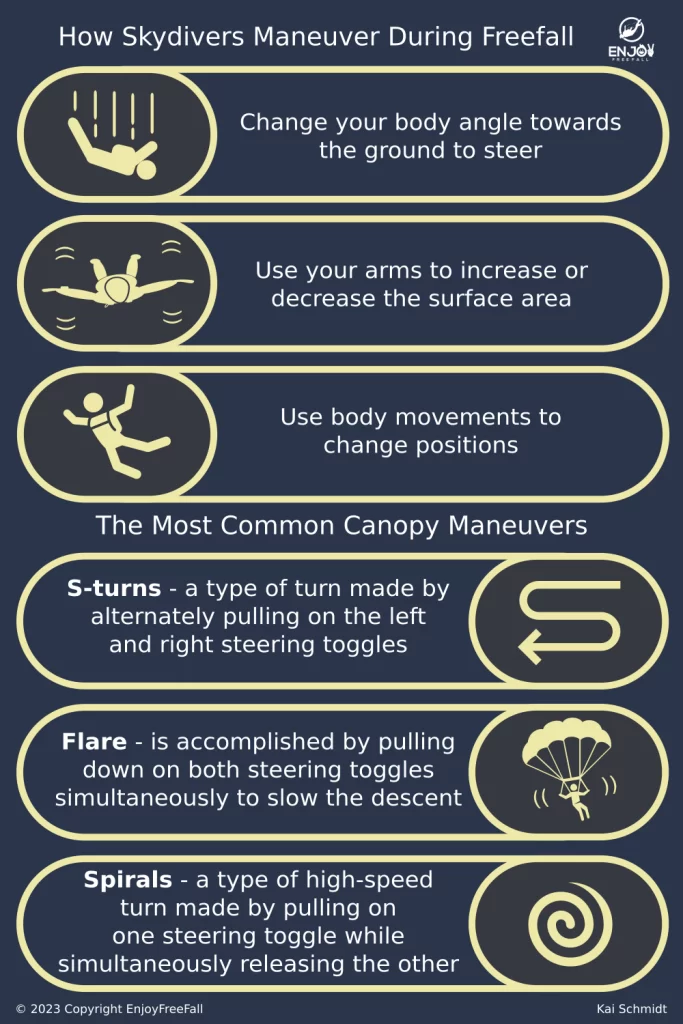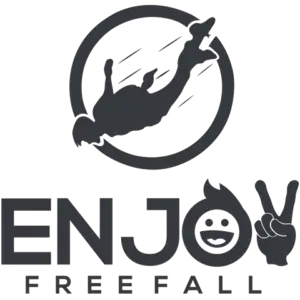
Skydiving is an exciting adventure that takes you to new heights – literally. As you hurtle toward the ground at high speeds, it may seem like you are at the mercy of gravity. Have you ever wondered how skydivers have the ability to maneuver, even while in a state of freefall?
As a general rule, skydivers use various body movements, including arching and de-arching, along with their arms and legs, to manipulate the airflow around them and thereby maneuver through the sky. The canopy is steered by steering toggles and changing the weight distribution in the harness.
In the following, I will explain in more detail how skydivers maneuver during free fall and during canopy rides. I will also explain the most important maneuvers and solve some misconceptions about floating in the air.
How Skydivers Maneuveur During Fee Falling
Maneuvering during a free fall is all about changing the way the air floats around you. It is usually easiest (even though not mandatory) to maneuver once you have reached terminal velocity. Terminal velocity is the maximum attainable speed during free fall in which the air resistance equals the gravitational pull.
If you want to learn more about terminal velocity, make sure to read my article about the distance and time to reach terminal velocity – it will provide you with interesting insights about the role of terminal velocity in skydiving.
Once you have reached terminal velocity, it often feels as if you can fly because the air resistance allows you to move through the sky in the best possible way. Here are the three ways to fly during free fall.
Change the Angle Between Yourself And the Ground to Steer During Free Fall
The first way to change the way that air flows around you is to change the angle between you and the ground. For example, pressing your head forward while pulling your hip up while you are in a belly-to-earth position will increase the angle between your body and the ground.
As the result, the air will float more diagonally to your body front thereby allowing you to move forward. It will also increase your falling speed because your relative surface area is decreased. Similarly, you can fly backward when you press your head back and the hip more downwards.
Use Your Arms to Maneuveur in the Sky
The second way to maneuver is by using your arms. You can use your arms to increase or decrease the surface area and manipulate the way the air floats.
For example, if you put your left arm more down and the right arm more up, you will channel the air from your left to the right. This will result in a leftward drop.
Similarly, you can put your arms in front of your head. You will experience more air resistance at the front of the body, pushing your body front more upwards.
Use Body Movements to Change Positions During a Skydive
By leveraging your body control, you can change your position during a skydive. This will again change the way that air floats around you.
For example, turning your hips and shoulders around will move your body around. In this way, skydivers move from a belly-to-earth position to a back-to-earth position.
Similarly, you can change from a belly-to-earth position to a sitting position, by pushing your head back and pulling the legs against your stomach.

How Skydivers Steer the Canopy
Canopies are steered by the use of steering toggles and by redistributing weight under the canopy. Both methods change the angle of the canopy, the ground, and the existing wind, thereby changing the way air floats in the canopy and the direction of the canopy.
As you can see, the principles of steering canopies and maneuvering freefalling are the same. However, the canopy typically allows for much better and easier steering because the surface area of the canopy is much bigger than that of the body, providing greater leverage and steering impact.
The speed under the canopy is also much lower, increasing the effect of the steering. This is really important because it allows skydivers to navigate to their destined drop zone.
Bonus tip: It can also be quite fun to perform different maneuvers during the canopy ride. If you are a tandem jumper, ask your tandem instructor to perform one of the following three maneuvers:
- S-turns: S-turns are a type of turn made by alternately pulling on the left and right steering toggles to create a zigzag pattern in the flight path. This maneuver is used to increase or decrease the horizontal speed of the canopy, and can also be used to navigate around obstacles or adjust the landing pattern.
- Flares: A flare is a maneuver used to slow the descent rate of the canopy during the landing. This is accomplished by pulling down on both steering toggles simultaneously, which causes the canopy to decrease its forward speed and increase its lift. The result is a slower and softer landing.
- Spirals: Spirals are a type of high-speed turn made by pulling on one steering toggle while simultaneously releasing the other. This maneuver causes the canopy to turn in a corkscrew pattern, with the descent rate increasing as the turn becomes tighter. Spirals can be used for fun or to lose altitude quickly. But be careful, spirals can cause a stomach drop and make you panic a little bit.
How Do Skydivers Float in the Air?
Skydivers do not float in the air as is commonly believed. Instead, they are in a state of freefall, accelerating toward the ground at a high speed of 120-185 mph. This common misconception is caused by skydiving videos in which the videographer falls at the same rate as the filmed skydiver.
This may be surprising to some people who have watched skydiving videos and have been under the impression that skydivers are floating in the air. However, it can be difficult to perceive the rate of descent on skydiving videos without any anchor points for reference.
Because skydivers are jumping from 10,000-15,000 ft, one can not really observe if the ground is coming closer or not. The ground looks more or less the same, whether a skydiver is at 15,000 ft, 13,000 ft, or 10,000 ft. The only other anchor points would be objects in the air such as the videographer. However, because the videographer is falling at the same rate, it looks like the filmed skydiver is floating.
There are, however, some instances in which witty watchers can observe the rate of descent on skydiving videos:
- Scenario 1 – the videographer or filmed pulls the parachute: In this scenario, you will see that either the filmed skydiver falls to the ground as the videographer is slowed down by the parachute or vice versa. Due to this change of relative speed, it will be more visible that one is falling during skydiving.
- Scenario 2 – an aircraft is shown or the video is filmed from an aircraft: Filming a skydiver from the aircraft can also reveal their true falling speed, as it becomes clear that they are in fact rushing towards the ground. Vice versa, when a videographer turns around and films the aircraft, one can see that the aircraft is getting farther away.
- Scenario 3 – objects with different surface areas are thrown around: When skydivers throw objects, the speed at which those objects fall can help to provide a reference point for the rate of descent.
If you’re looking for the ultimate way to float and fly through the sky and experience true freedom, you need to check out wingsuit flying. I’ve written an article that reveals the greatest distances ever traveled by wingsuit pilots – trust me, you won’t want to miss it!
That being said, enjoy your free fall!


